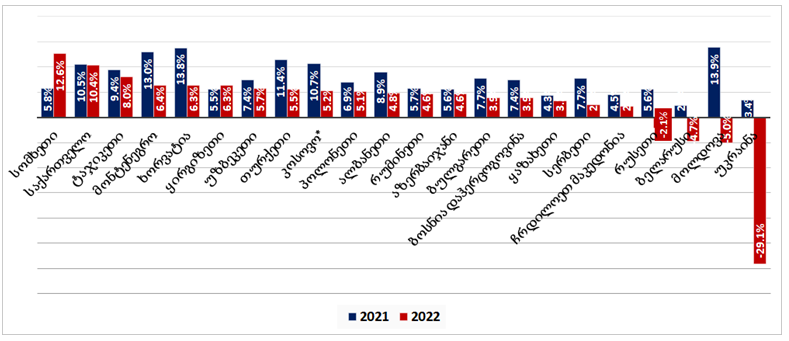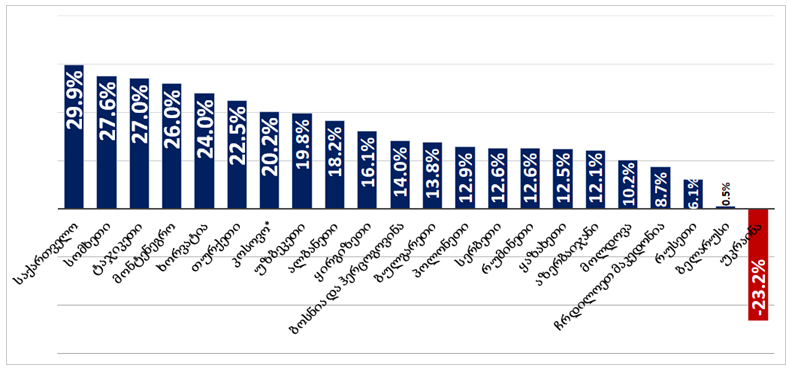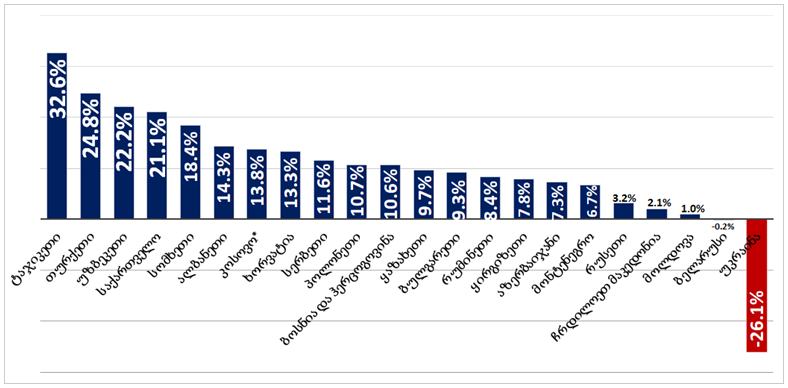Ministry of Economy: “Georgia demonstrates one of the highest rates of economic growth in the broader region.”
Verdict: FactCheck concludes that Levan Davitashvili’s statement is HALF TRUE.
The majority of countries worldwide have witnessed above-average economic growth rates following the significant decline in 2020 with Georgia having experienced a similar pattern and achieving a GDP growth rate of 10.5%. This double-digit growth persisted the subsequent year with the economy expanding by 7% in 2023 according to preliminary data.
The World Bank categorises Georgia within the Europe and Central Asia group comprising 22 countries[1]. Georgia ranked sixth in the group in terms of the economic growth rate in 2021, later ascending to the second place in 2022 and currently holding the third position as per preliminary data for 2023. Although Georgia leads the ranking with a 30% economic growth having aggregated the three years, the country falls to the fourth place when calculating for a four-year period. The economic growth of Tajikistan exceeded 32% whilst the Georgian economy grew by 21% in the years spanning 2020-2023. Had the annual growth rate from 2020 to 2023 been 5% mirroring the 2019 rate, the cumulative growth for the country would have matched the aforementioned figures.
Despite the factual accuracy of the Ministry of Economy’s statement, it, nonetheless, lacks clarification regarding one of the primary contributors of the double-digit growth in 2022 – namely, the drastic surge in cash transfers from Russia. The statement also overlooks the fact that the Georgian economy contracted more as compared to other countries in 2020 which equalised the average growth rate of 2020-2023 with the 2019 value.
Given the factual accuracy of the data but a lack of further clarification, as well as having failed to acknowledge the comparably larger fall during the pandemic, FactCheck concludes that the statement by the Ministry of Economy and Sustainable Growth is HALF TRUE.
Analysis:
Levan Davitashvili, the candidate for the Minister of Economy and Sustainable Growth, underlined Georgia’s economic growth in his discussion during a parliamentary committee meeting. The Ministry’s Facebook post reads: “According to Levan Davitashvili, Georgia not only overcame economic obstacles during the pandemic but also demonstrated one of the highest economic growth rates in the broader region, particularly amongst Europe and European Union candidate members.”
The Georgian economy experienced double-digit growth rates in 2021 and 2022, reaching 10.5% and 10.4%, respectively. Preliminary data for 2023 highlight a continued growth of 7%, exceeding the pre-pandemic growth rates.
The majority of countries globally exhibited above-average rates of economic growth following the 2020 downturn with the above-average growth tendency persisting in the subsequent year.
The World Bank categorises Georgia into a region comprised of 22 countries within Europe and Central Asia. Particularly, the group includes 11 post-Soviet states, all European Union candidate members and four European Union countries: Bulgaria, Romania, Croatia and Poland.
Georgia ranked sixth with a 10.5% growth in 2021 in the group with Moldova leading the ranking with a 13.9% growth. Additionally, Georgia was surpassed by Croatia, Montenegro, Turkey and Kosovo. Georgia surged to the second place in 2022, surpassed only by Armenia.
Graph 1: GDP Growth Rate in the Europe and Central Asia Region

Source: World Bank
Despite the base effects of the pandemic largely dissipating in 2022, Russia invaded Ukraine, resulting in a 29% contraction of the Ukrainian economy. Although less severe than anticipated, the Russian economy, nonetheless, contracted by 2.1% following the sanctions. The economy of Belarus, as an ally of Russia, fell by 4.7%.
Amongst the 22 countries in the Europe and Central Asia region, growth rates declined for 20 of them in 2022 as compared to 2021 with Armenia and Kyrgyzstan being the exceptions. Notably, given that the difference of 0.1 of a percentage point is not acknowledged, it can also be inferred that Georgia managed to maintain its prior growth tendency.
Despite the potential for significantly reduced growth rates due to the disappearance of base effects and the large-scale war in the region, Georgia’s situation differed.
Georgia did not join the sanctions against Russia, instead contextually taking responsibility to enforce them. Exports to Russia increased modestly but imports significantly increased primarily due to fuel. The availability of comparably cheaper fuel helped dampen the inflation rate in Georgia.
The economic relationship between Georgia and Russia in 2022 witnessed the highest differences regarding migration and cash transfers. Over 56,000 Russian citizens remained in Georgia as residents for over six months. Additionally, Russian citizens purchased over 8,000 plots of real estate in the 16 months following the beginning of the war whilst cash transfers from Russia exceeded USD 2 billion, marking a 400% growth.
The growth effect stemming from the inflow of Russian migrants slowed down, leading to a contraction in GDP growth to 7% in 2023 according to preliminary data. Despite this reduction, the growth observed in 2023 exceeds both figures for the periods prior to the pandemic and the projected values for the moderate term in the future.
The data for 2023 are only an estimate, thus they may be subject to correction. Additionally, the report highlights a growth totalling 6.5% which differs by 0.5 of a percentage point from GeoStat’s preliminary data. However, it is less likely that these estimates will undergo further drastic changes as they have already been corrected once. As a result, Georgia is positioned as the third-highest in the region, surpassed by Tajikistan and Armenia.
Georgia holds the first position with a 30% cumulative growth rate for 2021-2023 with Armenia and Tajikistan following with 28% and 27% growth rates, respectively. Russia exhibited a 6% growth, Azerbaijan was at 12% and Turkey at 22%.
Graph 2: Cumulative Economic Growth in 2021-2023 in the Europe and Central Asia Region

Source: World Bank
Although Georgia ranks first in terms of cumulative economic growth in the region, it drops to the fourth place when considering 2019 as the base year. Despite the fact that the Georgian economy contracted by 6.8% in 2020, in line with many other countries, the economies of Tajikistan, Uzbekistan and Turkey demonstrated growth rates of 4.4%, 2% and 1.9%, respectively. As a result, the cumulative growth of Tajikistan for the years spanning 2020-2023 surpassed 32% and Turkey’s cumulative growth exceeded 24% whilst Georgia’s cumulative growth totalled 21%. Had the annual growth rate from 2020 to 2023 been 5%, reflecting the 2019 rate, the cumulative growth for the country would have matched the aforementioned figures.
Graph 3: Cumulative Economic Growth in 2020-2023 in the Europe and Central Asia Region

Source: World Bank
Georgia did indeed exhibit one of the highest growth trends during the aforementioned three-year period. Furthermore, Georgia secured the top spot in terms of cumulative growth with the substantial increase in cash flows from Russia in 2022 playing a crucial role in this tendency. However, when considering the cumulative growth for the four-year period (2020-2023), the country dropped to the fourth position. Given the factual accuracy but a lack of further clarification on the underlying factors, as well as having failed to acknowledge the comparably larger fall during the pandemic, FactCheck concludes that the statement by the Ministry of Economy and Sustainable Growth is HALF TRUE.








